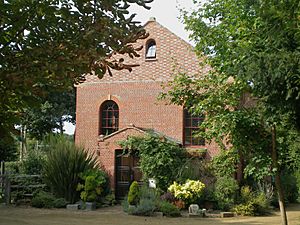Zion Chapel, Newick facts for kids
Quick facts for kids Zion Chapel |
|
|---|---|

The chapel from the southeast
|
|
| 50°58′29″N 0°00′33″E / 50.9746°N 0.0091°E | |
| Location | Western Road, Newick, East Sussex BN8 4LF |
| Country | England |
| Denomination | Baptist |
| History | |
| Status | Former chapel |
| Founded | 14 October 1833 |
| Architecture | |
| Functional status | Residential conversion |
| Heritage designation | Grade II |
| Designated | 27 September 1979 |
| Style | Classical |
| Completed | 1834 |
| Closed | 2001 |
Zion Chapel was once a church for a group called Strict Baptists in the village of Newick. Newick is in East Sussex, England. This small building opened in 1834. It was one of three places where people could worship in Newick. The area of Sussex where it was built had many different kinds of Protestant churches. Zion Chapel was used until 2001. Then, it was sold and changed into homes. Today, the chapel is a Grade II listed building. This means it is an important historical building that needs to be protected.
Contents
The History of Zion Chapel
Newick village is located north of Lewes in Sussex. It is near the River Ouse. The village was not mentioned in the old Domesday Book from 1086. However, it might have been part of a nearby place called Allington. Newick was connected to villages like Barcombe and Hamsey a long time ago. A church was already in Newick by 1147.
The Rise of Different Churches
Starting in the 1600s, many different Protestant groups became popular in Sussex. These groups were called Nonconformists. They built small churches, or chapels, in many villages. These included General Baptists, Strict Baptists, Quakers, and Methodists.
Zion Chapel was one of these chapels. It was built in 1834 on the main road from Haywards Heath to Uckfield. We do not know who designed it or who started it. The land for the chapel was given on October 14, 1833. It was given to "certain dissenters from the Church of England." These people were also called Calvinistic Baptists. They paid a small fee for the land. The year 1834 was carved on the entrance porch.
Chapel Life and Changes
In 1851, a survey of churches in Sussex was done. It showed that Zion Chapel had 300 seats. About 250 of these seats were free for anyone to use. Around 130 people came to the morning service. About 50 people attended the afternoon service. The building was also used for Sunday school classes. The minister, John Poynder, said that bad weather could affect how many people came.
Zion Chapel served the Strict Baptist community for many years. Other similar chapels were in nearby towns like Wivelsfield and Lewes. Over time, fewer people attended Zion Chapel. In 2001, the church decided to sell the building. It had been given Grade II listed status in 1979. This special status helped protect it from being torn down or changed too much. The local council allowed the building to be made into three homes. This new group of homes was named Chapel Grove.
The Look of Zion Chapel
The chapel is a small building. It is made of red and grey bricks. It has a simple but interesting design. The front of the building, which faces the street, has two windows with rounded tops. There is also an entrance porch with a pointed roof, called a gable. The year 1834 is carved on this porch.
Above the porch is a triangular part called a pediment. It has a round shape carved into it, like an eye. A special thing about the pediment is how the bricks are laid. Red and grey bricks are used in a pattern called Flemish bond. This makes a regular design. The other walls of the chapel are made only of red bricks.
Behind the chapel, there is a cemetery. This cemetery is not part of the protected area around the chapel. However, the local council has thought about including it.
See also

